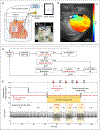A transient, closed-loop network of wireless, body-integrated devices for autonomous electrotherapy
- PMID: 35617386
- PMCID: PMC9282941
- DOI: 10.1126/science.abm1703
A transient, closed-loop network of wireless, body-integrated devices for autonomous electrotherapy
Abstract
Temporary postoperative cardiac pacing requires devices with percutaneous leads and external wired power and control systems. This hardware introduces risks for infection, limitations on patient mobility, and requirements for surgical extraction procedures. Bioresorbable pacemakers mitigate some of these disadvantages, but they demand pairing with external, wired systems and secondary mechanisms for control. We present a transient closed-loop system that combines a time-synchronized, wireless network of skin-integrated devices with an advanced bioresorbable pacemaker to control cardiac rhythms, track cardiopulmonary status, provide multihaptic feedback, and enable transient operation with minimal patient burden. The result provides a range of autonomous, rate-adaptive cardiac pacing capabilities, as demonstrated in rat, canine, and human heart studies. This work establishes an engineering framework for closed-loop temporary electrotherapy using wirelessly linked, body-integrated bioelectronic devices.
Conflict of interest statement
Figures




Comment in
-
Remote control of the heart and beyond.Science. 2022 May 27;376(6596):917-918. doi: 10.1126/science.abq0605. Epub 2022 May 26. Science. 2022. PMID: 35617399
References
MeSH terms
Grants and funding
LinkOut - more resources
Full Text Sources
Other Literature Sources
Medical

